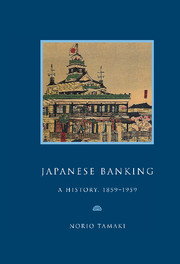Book contents
- Frontmatter
- Contents
- Preface
- Genealogy of leading Japanese banks, 1859–1959
- List of abbreviations
- Map
- Part I A bankrupt Shogunate, 1859–1868
- Part II The Meiji Restoration: monetary confusion and banking experiments, 1868–1881
- Part III Matsukata, the wizard of Japanese banking, 1881–1897; the Yokohama Specie Bank (1880) and the Bank of Japan (1882)
- Part IV The Japanese on the London money market, 1897–1911
- Part V War, the Japanese boom years, 1911–1919
- Part VI Crisis and the road to war, 1919–1937
- Part VII Complete commitment, struggle and defeat, 1937–1945
- Part VIII American ‘democratisation’ and the search for growth, 1945–1959
- Historical background
- 28 MacArthur's directives, 1945–1948
- 29 Remaking the banking system: the Japanese versus the Americans, 1946–1952
- 30 The rise of governmental banking and the search for stability: Japanese initiatives, 1949–1958
- 31 The post-war system, 1946–1959
- An extraordinary century, 1859–1959
- Appendices
- Notes
- Bibliography
- Index
Historical background
Published online by Cambridge University Press: 03 February 2010
- Frontmatter
- Contents
- Preface
- Genealogy of leading Japanese banks, 1859–1959
- List of abbreviations
- Map
- Part I A bankrupt Shogunate, 1859–1868
- Part II The Meiji Restoration: monetary confusion and banking experiments, 1868–1881
- Part III Matsukata, the wizard of Japanese banking, 1881–1897; the Yokohama Specie Bank (1880) and the Bank of Japan (1882)
- Part IV The Japanese on the London money market, 1897–1911
- Part V War, the Japanese boom years, 1911–1919
- Part VI Crisis and the road to war, 1919–1937
- Part VII Complete commitment, struggle and defeat, 1937–1945
- Part VIII American ‘democratisation’ and the search for growth, 1945–1959
- Historical background
- 28 MacArthur's directives, 1945–1948
- 29 Remaking the banking system: the Japanese versus the Americans, 1946–1952
- 30 The rise of governmental banking and the search for stability: Japanese initiatives, 1949–1958
- 31 The post-war system, 1946–1959
- An extraordinary century, 1859–1959
- Appendices
- Notes
- Bibliography
- Index
Summary
The saturation bombing of Japanese cities, which started in February 1945, and the two atomic bombs dropped on Hiroshima and Nagasaki on 6 and 9 August that year, brought Japan to her knees. Upon the Emperor's insistence, Japan unconditionally accepted the Potsdam Declaration on 15 August 1945 and the Japanese people found themselves in an extraordinary situation. The Americans occupied Japan and there followed an avalanche of major decisions. Supreme war leaders were put on trial, and many officials were purged from their appointments. The Emperor himself renounced his divinity. Women's suffrage was introduced and trade union activities became legal. In November 1946, under American guidance, the new constitution was promulgated, becoming effective in May 1947. ‘Democratisation’, which the Americans used to redirect the Japanese, became a slogan lingering on far beyond the following decade. By 1950 American foreign policy had changed rapidly due to the cold war against the rising tide of communism. Japan was rapidly transformed from enemy to ally. The American concentration on Japanese ‘democratisation’ had passed, a relief for the Japanese. The cold war erupted with the Korean War in 1950, which created a tremendous amount of demands for Japanese products. As a result of the Korean War, Japan recovered her sovereignty in 1952 and the Japanese economy resumed its growth. The Japanese banks, never penetrated by American ‘democratisation’, had by 1950 recovered from the disaster of war and were ready for take-off.
- Type
- Chapter
- Information
- Japanese BankingA History, 1859–1959, pp. 185Publisher: Cambridge University PressPrint publication year: 1995

